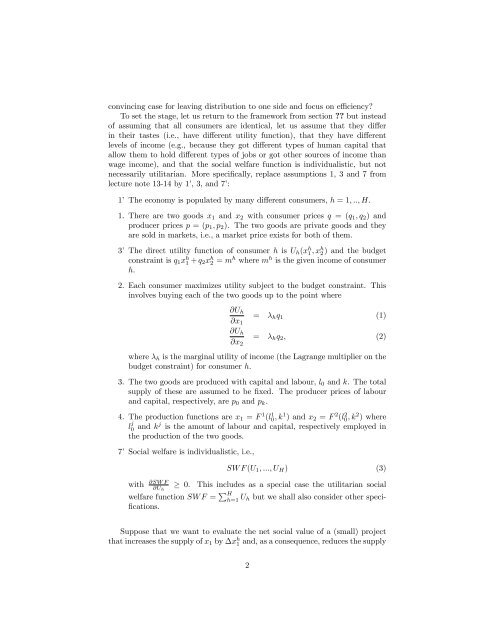Lecture Note 15: Social Cost Benefit Analysis - University of ...
Lecture Note 15: Social Cost Benefit Analysis - University of ...
Lecture Note 15: Social Cost Benefit Analysis - University of ...
Create successful ePaper yourself
Turn your PDF publications into a flip-book with our unique Google optimized e-Paper software.
convincing case for leaving distribution to one side and focus on e¢ ciency?<br />
To set the stage, let us return to the framework from section ?? but instead<br />
<strong>of</strong> assuming that all consumers are identical, let us assume that they di¤er<br />
in their tastes (i.e., have di¤erent utility function), that they have di¤erent<br />
levels <strong>of</strong> income (e.g., because they got di¤erent types <strong>of</strong> human capital that<br />
allow them to hold di¤erent types <strong>of</strong> jobs or got other sources <strong>of</strong> income than<br />
wage income), and that the social welfare function is individualistic, but not<br />
necessarily utilitarian. More speci…cally, replace assumptions 1, 3 and 7 from<br />
lecture note 13-14 by 1’, 3, and 7’:<br />
1’ The economy is populated by many di¤erent consumers, h = 1; ::; H.<br />
1. There are two goods x1 and x2 with consumer prices q = (q1; q2) and<br />
producer prices p = (p1; p2). The two goods are private goods and they<br />
are sold in markets, i.e., a market price exists for both <strong>of</strong> them.<br />
3’ The direct utility function <strong>of</strong> consumer h is Uh(x h 1; x h 2) and the budget<br />
constraint is q1x h 1 + q2x h 2 = m h where m h is the given income <strong>of</strong> consumer<br />
h.<br />
2. Each consumer maximizes utility subject to the budget constraint. This<br />
involves buying each <strong>of</strong> the two goods up to the point where<br />
@Uh<br />
@x1<br />
@Uh<br />
@x2<br />
= hq1 (1)<br />
= hq2; (2)<br />
where h is the marginal utility <strong>of</strong> income (the Lagrange multiplier on the<br />
budget constraint) for consumer h.<br />
3. The two goods are produced with capital and labour, l0 and k. The total<br />
supply <strong>of</strong> these are assumed to be …xed. The producer prices <strong>of</strong> labour<br />
and capital, respectively, are p0 and pk.<br />
4. The production functions are x1 = F 1 (l 1 0; k 1 ) and x2 = F 2 (l 2 0; k 2 ) where<br />
l j<br />
0 and kj is the amount <strong>of</strong> labour and capital, respectively employed in<br />
the production <strong>of</strong> the two goods.<br />
7’ <strong>Social</strong> welfare is individualistic, i.e.,<br />
with<br />
@SW F<br />
@Uh<br />
SW F (U1; :::; UH) (3)<br />
0. This includes as a special case the utilitarian social<br />
welfare function SW F = P H<br />
h=1 Uh but we shall also consider other speci-<br />
…cations.<br />
Suppose that we want to evaluate the net social value <strong>of</strong> a (small) project<br />
that increases the supply <strong>of</strong> x1 by x h 1 and, as a consequence, reduces the supply<br />
2


